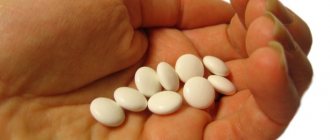Indapamide is a diuretic and belongs to the class of thiazide diuretics. Typically used to treat arterial hypertension, as well as heart failure. Indapamide has been shown in HYVET to reduce mortality in patients over 80 years of age when treating hypertension.
The drug is available in dosages of 1.25 and 2.5 mg (milligrams) in tablet form. Currently there is also a sustained release SR (sustained release) form.
Spironolactone
Spironolactone belongs to the group of potassium-sparing diuretics. Produced by many pharmaceutical companies in the form of tablets, the type of packaging may vary. The main active ingredient is also called spironolactone.
The product is widely used:
- to eliminate swelling in patients suffering from chronic heart failure, cirrhosis of the liver, during pregnancy (in the 2nd and 3rd trimester);
- with increased secretion of aldosterone by the adrenal glands;
- hypertension;
- in the treatment of polycystic ovary syndrome and premenstrual syndrome.
A positive property of the medication is that when excess fluid is removed from the body, there is no disturbance in the electrolyte balance of the blood plasma. Spironolactone is a mild diuretic, the effect after starting treatment appears after 2-5 days.
It has a number of undesirable side effects: gynecomastia, impotence, hirsutism, hyperkalemia, menstrual irregularities.
special instructions
Often, after stabilizing the pressure and feeling well, patients stop using medications.
This is a wrong decision; doctors advise taking Indapamide constantly.
Reducing the dosage or completely stopping the medication should only be done under the supervision of a physician.
An important step is regular blood tests for creatinine, potassium, and other indicators that will interest the doctor.
In the first week of taking Indapamide, you should avoid working with dangerous machinery or driving a car. When you are sure that the medicine does not have negative effects, return to your previous lifestyle. The drug can be used regularly for six to nine months, after which you can consult your doctor for recommendations.
Veroshpiron
The drug Veroshpiron is actually an analogue of Spironolactone, since it contains the same active ingredient in 25, 50 and 100 mg doses, in tablets and gelatin capsules.
The only difference is that Veroshpiron is always produced by one company, GEDEON RICHTER, Plc. (Gedeon Richter) at factories in Hungary or Russia. All of the listed effects of Spironolactone also apply to the drug Veroshpiron.
Release form and dosage
The original medicine containing indapamide is produced by the pharmaceutical company Servier under the brand name Arifon. In addition to the original Arifon, many generics with indapamide are registered in Russia, including those under the same name Indapamide. Arifon analogues are produced in the form of capsules or film-coated tablets. Recently, drugs with modified release of indapamide from the tablet have become popular.
In what forms is it available and how much does Indapamide cost:
| Release form | Dosage, mg | Manufacturer | A country | Price per month of treatment, rub. |
| Indapamide tablets | 2,5 | Pranapharm | Russia | from 18 |
| AlsiPharma | ||||
| Pharmstandard | ||||
| Biochemist | ||||
| PromomedRus | ||||
| Ozone | ||||
| Welfarm | ||||
| Avva-Rus | ||||
| Canonpharma | ||||
| Obolenskoe | ||||
| Valenta | ||||
| Nizhpharm | ||||
| Teva | Israel | 83 | ||
| Hemofarm | Serbia | 85 | ||
| Indapamide capsules | 2,5 | Ozone | Russia | from 22 |
| Vertex | ||||
| Teva | Israel | 106 | ||
| Indapamide long-acting tablets | 1,5 | PromomedRus | Russia | from 93 |
| Biochemist | ||||
| Izvarino | ||||
| Canonpharma | ||||
| Tatkhimpharmaceuticals | ||||
| Obolenskoe | ||||
| AlsiPharma | ||||
| Nizhpharm | ||||
| KRKA-Rus | ||||
| MakizPharma | ||||
| Ozone | ||||
| Hemofarm | Serbia | 96 | ||
| Gedeon Richter | Hungary | 67 | ||
| Teva | Israel | 115 |
According to reviews from cardiologists, it is preferable to buy regular Indapamide in capsules. The medicine in capsules is stored longer, has higher bioavailability, is absorbed faster, contains fewer auxiliary components, and therefore less likely to cause allergies.
The most modern form of Indapamide is long-acting tablets. The active substance is released from them more slowly thanks to a special technology: small amounts of indapamide are evenly distributed in the cellulose. Once in the gastrointestinal tract, cellulose gradually turns into a gel. It takes about 16 hours for the tablet to dissolve.
Compared to conventional tablets, long-acting Indapamide provides a more stable and stronger hypotensive effect; daily fluctuations in blood pressure when taken are smaller. The potency of 2.5 mg of regular Indapamide is equal to 1.5 mg of long-term. Most side effects are dose-dependent, that is, their frequency and severity increases with increasing dose. Taking extended-release Indapamide tablets reduces the risk of side effects, primarily a drop in blood potassium levels.
You can distinguish extended-release Indapamide by the dosage of 1.5 mg. The packaging must indicate “extended action”, “modified release”, “controlled release”; the name may contain “retard”, “MB”, “long”, “SR”, “CP”.
Inspra
Inspra is also a potassium-sparing diuretic. The drug effectively removes excess fluid, removes swelling, while preventing the loss of a microelement, potassium, necessary for the full and proper functioning of the heart muscle.
Inspra is produced in tablet form by PFIZER, Inc. (Pfizer), USA. The active ingredient is eplerenone, containing 25 mg in pills. Created later than spironolactone and has fewer side effects. With long-term therapy with Inspra, patients with chronic coronary insufficiency develop fewer side effects. Practically does not cause gynecomastia, hirsutism, or impotence. No dose adjustment is required, which is important for therapy for people with diabetes, the elderly and those with reduced renal function.
Possible side effects
The medicine Indapamide may cause unwanted effects when used. Deviations usually concern the following systems:
- nervous (central and peripheral parts);
- cardiovascular;
- respiratory;
- digestive;
- urinary.
The patient may experience dizziness, some people experience disturbed sleep, depression, apathy and drowsiness, and asthenic syndrome. Sometimes there is severe irritability, excitability, and a constant feeling of overwork. Disorders of peripheral sensitivity and muscle spasms of the extremities were also recorded.
The heart may develop rhythm disturbances, changes appear on the cardiogram, and a decrease in potassium in the blood leads to changes in the conduction system of the heart muscle. The patient may experience a strong decrease in pressure when moving from a horizontal to a vertical position.
Disturbances in the functioning of the upper respiratory tract are manifested by cough, runny nose, inflammation of the pharynx, and bronchospasm.
Indapamide tablets may sometimes cause loss of appetite, dry mouth, nausea and vomiting. Pain and cramping in the abdomen and stool disturbances (diarrhea or constipation) appear less frequently. Occasionally, exacerbation of pancreatitis is observed. If a person taking the drug has serious liver problems, then signs of hepatic encephalopathy may appear during therapy.
An infection may develop in the kidneys and underlying urinary tract due to the use of this diuretic. Sometimes the patient experiences an increase in urine output at night (nocturia) or polyuria.
The functioning of the hematopoietic system may be disrupted: usually there is a decrease in platelets and leukocytes in the blood, agranulocytosis develops, the likelihood of bleeding increases, and clotting time decreases. Hemolytic anemia and bone marrow aplasia are also possible.
Intolerance to the components included in the drug may be accompanied by allergic manifestations. Usually, urticaria, itching and burning of the skin, and a rash in the form of papules or spots are noted.
During a course of taking Indapamide, the mineral composition of the blood changes. The level of calcium and plasma glucose increases, hyperuricemia, and the level of sodium chloride decreases. If kidney function is impaired, urea and creatinine may increase. Therefore, the level of these connections must be constantly checked.
Usually, side effects occur infrequently, but if they occur, it is recommended to immediately stop taking the drug and consult a doctor to adjust treatment.
Hypothiazide
Hypothiazide is a first-generation thiazide diuretic drug with moderate diuretic and antihypertensive effects. The active substance is hydrochlorothiazide. They are used both in monotherapy and in combination with drugs from other pharmacological groups. Enhances the excretion of potassium, magnesium, bicarbonate and phosphate ions from the body in the urine. Retains calcium and urate ions.
After oral administration, the effect of the drug occurs very quickly, within half an hour, and lasts for 6-14 hours. The mild effect of Hypothiazide is used to treat the following ailments:
- hypertension;
- chronic edema;
- diabetes insipidus;
- for the prevention of stone formation in the urinary organs in patients with hypercalciuria.
Hypothiazide can be taken for a long time, but electrolyte levels should be periodically monitored by laboratory blood tests.
It also causes significantly the following negative metabolic side effects:
- increases the level of cholesterol, low and very low density lipoproteins, triglycerides;
- reduces glucose tolerance;
- increases hyperuricemia.
Therefore, some doctors prefer Indapamide as a more advanced drug.
Home information
- Do you have questions about indapamide? Talk to your doctor.
- Indapamide should only be used by the person for whom it is prescribed. Do not share the drug with other people!
- If the symptoms of your disease do not improve, but only get worse, talk to your doctor.
This information should not be used to decide whether to take this drug or any other medicines. Only your doctor has the knowledge and skills to decide which medications are right for you. This information does not promote any drugs as safe, effective, etc. This is just a short general information about indapamide. It does not include all of the possible uses, precautions, interactions, side effects, or risks that may occur with indapamide. This information is not advice and does not replace the information you receive from your healthcare provider. You should talk to your doctor for complete information about the risks and benefits of using indapamide.
Indapamide
Indapamide contains the active substance of the same name. Belongs to the group of thiazide diuretics. It has a moderate diuretic effect, removes sodium from the body, and has little effect on the level of potassium and uric acid. Causes a decrease in peripheral vascular resistance and blood pressure. The advantage of the drug is that the effect of indapamide is maintained in the early hours, when the risk of cardiovascular complications is especially high.
After taking the tablet, the diuretic effect occurs within an hour and lasts up to 12-18 hours. In tablets with a delayed release of the active component (Indapamide retard), the effect lasts up to 24 hours. Taking the prolonged form helps reduce hypertrophy of the left ventricle of the heart. Does not affect carbohydrate and lipid metabolism even in patients with diabetes.
Usually the drug is prescribed 1-2 times a day, in the morning for arterial hypertension and cardiac edema. A lasting therapeutic effect is achieved by continuous use of the medication for at least 3 months.
What is the difference
The difference between the presented drugs is as follows:
- "Indapamide" has a milder and more gentle effect on the body.
- Furosemide has an extensive list of contraindications and side effects. And the side effects appear more clearly and more often than with the second medication.
- Due to the power of the diuretic effect, Furosemide is used as needed. For the second medication, a course intake is provided. Moreover, some patients use it for several years.
- Despite the mildness and relative safety of Indapamide, pregnant women and persons under 18 years of age are prohibited from taking it. Another drug may be prescribed in case of emergency for both pregnant women and children.
- Furosemide has both solid (tablets) and liquid (solution) release forms. The second remedy is available only in pills.
- The drugs also differ in their chemical composition . They have various active components.
The difference in prices, although not critical, is also present. "Indapamide", depending on the manufacturer, costs from 16 to 110 rubles . "Furosemide" of any release format - from 19 to 23 rubles .
Furosemide
The drug Furosemide is not only the most common and popular among diuretics, but also the most powerful. Belongs to the group of loop diuretics. Available in the form of tablets and solution for injection.
The drug very quickly removes excess fluid, as well as sodium salts. The drug helps to quickly reduce blood pressure, eliminates swelling caused by various pathologies of the liver, heart and kidneys. In emergency treatment, Furosemide injection is required for swelling of the brain, lungs, and hypertensive crisis.
The active substance of the same name (furosemide) after taking the Furosemide tablet orally begins to act within 30-60 minutes, after injection - after 5-10 minutes. The duration of the effect is 2-3 hours. When using the drug once a day, no significant antihypertensive effect is observed.
Advantages of Furosemide:
- very strong diuretic effect;
- effective for severe swelling.
The disadvantages include a large list of side effects and contraindications. Long-term use of the drug can lead to dehydration and disruption of the electrolyte balance of blood plasma. This is hypokalemia, leading to muscle weakness, anorexia, constipation and heart rhythm disturbances. Furosemide also increases the excretion of calcium and magnesium from the body, but increases the level of uric acid.
It is recommended to use the drug only as prescribed by a doctor. Take with extreme caution if you have kidney disease.
Interaction with other drugs
A person is often forced to take several drugs belonging to different drug groups. Their active substances may reduce or enhance the effectiveness of Indapamide. It is worth taking a closer look at how such “interactions” manifest themselves.
The hypotensive effect of the drug increases when used together with antidepressants and antipsychotics - this can cause a sharp drop in blood pressure.
When combined with Erythromycin, a person experiences tachycardia; when combined with Cyclosporine, the level of creatinine increases. Simultaneous use with drugs that contain iodine can cause dehydration. Potassium loss is promoted by laxatives, saluretics and cardiac glycosides.
It should be borne in mind that corticosteroids and NSAIDs (non-steroidal anti-inflammatory drugs) reduce the hypotensive effect of Indapamide - this reduces the effectiveness of the drug. To avoid such interactions with other medications, the doctor needs to provide a list of all medications and herbal medicines used.
Torasemide
The drug Torasemide belongs to the group of loop diuretics, like furosemide, but is a medicine of a new generation. It has a number of fundamental differences from furosemide:
- has a more pronounced diuretic and natriuretic effect;
- removes potassium to a lesser extent;
- the antihypertensive effect is not based on a decrease in circulating blood volume, but is caused by vasodilation and the elimination of vasospasm.
These properties allow the use of Torasemide in patients with arterial hypertension. The prolonged form can be combined in therapy with anticoagulants, cardiac glycosides, nitroglycerin and calcium channel blockers. Simultaneous use with potassium-sparing diuretics prevents electrolyte disturbances in the body.
The effect of the medicine begins an hour after taking it. The maximum effect of Torasemide occurs after 2 hours and lasts from 12 to 18 hours.
, and if used incorrectly can cause the development of an overdose and
.
Overdose
Cases of overdose are very rare. A toxic dose of 40 mg disrupts the water-salt balance in the body. Then the following symptoms appear:
- feeling of dry mouth and thirst;
- hypotension;
- oliguria/polyuria;
- weakness and nausea/vomiting;
- dizziness;
- drowsiness;
- muscle pain.
If such symptoms appear after taking Indapamide, you need to call an ambulance, rinse your stomach, and take enterosorbent - activated carbon. To restore your water balance, drink plenty of fluids.
Sources
- Spironolactone https://www.vidal.ru/drugs/spironolactone-2
- Verospiron instructions for use https://www.vidal.ru/drugs/verospiron__149
- Inspra® (Inspra) instructions for use https://www.vidal.ru/drugs/inspra__42133
- Verospilactone instructions for use https://www.vidal.ru/drugs/verospilactone__41964
- Indapamide https://www.vidal.ru/drugs/indapamide__39560
- Furosemide https://www.vidal.ru/drugs/furosemide__23309
- Torasemide https://www.vidal.ru/drugs/torasemide-3
- Diuver instructions for use https://www.vidal.ru/drugs/diuver__8865
- Hypothiazid® instructions for use https://www.vidal.ru/drugs/hypothiazid__1739
- T.E.Morozova, I.Yu.Yudina. The choice of diuretic drugs for the treatment of arterial hypertension in outpatient practice. Journal Directory of a polyclinic doctor. 2017; 03:38-42
Share:
Analogues and substitutes
The following drugs registered in the Russian Federation completely replicate the drug in composition and dosage, that is, they are complete analogues of Indapamide:
| Name | Form | Manufacturer | Price for 30 pcs., rub. | |
| regular | retard | |||
| Arifon/Arifon Retard | table | table | Servier, France | 345/335 |
| Indap | caps. | — | ProMedCs, Czech Republic | 95 |
| SR-Indamed | — | table | EdgePharma, India | 120 |
| Ravel SR | — | table | KRKA, RF | 190 |
| Lorvas SR | — | table | Torrent Pharmaceutical, India | 130 |
| Ionic/Ionic retard | caps. | table | Obolenskoye, RF | not available in pharmacies |
| Tenzar | caps. | — | Ozon, RF | |
| Indipam | table | — | Balkanfarma, Bulgaria | |
| Indiur | table | — | Polfa, Poland | |
| Akuter-Sanovel | — | table | Sanovel, Türkiye | |
| Retapres | — | table | Biopharm, India | |
| Ypres Long | — | table | SchwarzPharma, Poland | |
They can replace Indapamide without additional consultation with your doctor. According to reviews from patients who took the drugs, the highest quality tablets from this list are Arifon and Indap tablets.
Pharmacokinetics
After oral administration, the drug is completely and quickly absorbed from the gastrointestinal tract. The drug has high bioavailability - 93%. Eating slightly slows down the rate of absorption, but the amount of drug absorbed remains stable. The maximum concentration of the drug in the blood plasma is achieved 1-2 hours after oral administration. With regular use of indapamide, its concentration in the blood stabilizes after 7-9 days of use. The half-life of the drug is on average 18 hours. The drug binds to blood plasma proteins by 79%. The pharmacological agent also binds to the elastin of the myocytes of the vascular walls. Metabolism of the drug occurs in the liver. The drug is excreted 70% by the kidneys, mainly in the form of metabolites, and 20-30% through the intestines. The pharmacokinetics of the drug does not change in renal failure. Does not have a cumulative effect.
Contraindications
The medicine has the following contraindications:
- severe liver dysfunction;
- individual intolerance to components;
- chronic renal failure;
- presence of gout;
- decompensated stage of diabetes;
- deficiency of potassium or nitrogen in the blood;
- up to 18 years old;
- acute circulatory disorder occurring in the brain;
- pregnancy and breastfeeding.
It is highly undesirable to take the drug together with alcohol. Also, during competitions, professional athletes should refuse it during doping control, since it causes a positive test result.











